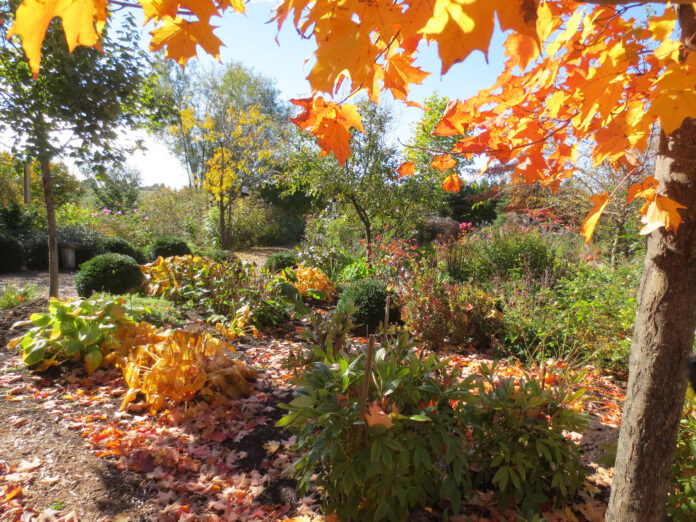
By Mark and Ben Cullen – Gardening
Gardeners live in a world of change. As we gain experience, we pay more attention to changes in our gardens as we spend time there.
At no time in the year is change more dramatic than now, during the change of colour in tree leaves and their drop to the ground. What is going on? And what happens to the leaves that we allow to remain in the garden, put in our compost or the ones that we mulch up with a power mower to rot on the lawn?
- Colour. Let’s look at the role of leaves, from the point of view of the tree. They are green because chlorophyl courses under the tree bark and out to the leaves during the growing season. Trees absorb long-wavelength red and short-wavelength blue regions of light spectrum to produce chlorophyl but reflect green which is what gives leaves their appearance. As the tree nutrients, and the sap carrying them, retreat to the root zone of the tree in the fall the chlorophyl is drained from the tree’s system. It is accurate to say that leaves do not change colour, but their true colours in the form of carotenoids pigments (orange yellow, present throughout the year) and anthocyanins (red purple, produced late in the season) are revealed in the absence of chlorophyl.
- Carbon. Fallen leaves are extremely rich in nutrients, particularly carbon. When environmentalists talk about the benefits of trees, they are acknowledging the process of sequestering carbon from the atmosphere as new growth wood and leaves. Carbon is captured from the atmosphere and stored in the tree. As CO2 is absorbed by the tree, oxygen is released in exchange. This quid pro quo arrangement is essential to human existence. Try breathing without a fresh supply of oxygen and you will understand.
- Soil. Fallen leaves provide a foundation for good soil, largely thanks to their high concentration of carbon which forms the backbone of good soil health. Think of Southern Ontario before the Europeans arrived about 500 years ago, cloaked as it was in a thick cover of diverse deciduous trees. Beneath this massive forest a thick layer of rotting leaves over 10,000 years old produced some of the finest quality soil in the world. One day a green, breathing leaf, soon a leaf falling to the earth like a wafer of fertilizer, a rotting host for beneficial bacteria, mycorrhiza and countless bugs and other living things in the bed made by the tree cover. Sadly, this is what made much of southwestern Ontario so attractive for agriculture, leading to the large-scale clear cutting of these old growth forests.
- Mulch. The benefits of mulch are well known; reduced erosion, retained moisture, and most importantly weed control. Why pay for coloured mulch when leaves, which are free, perform the same function? Besides, coloured mulch is unattractive anyway…not that this is an opinion column.
- Compost. The high carbon content of leaves is useful for balancing nitrogen content of kitchen scraps in your composter. A good recipe is 5-10 parts brown material such as leaves and cardboard to 1-part green material such as kitchen scraps. This is, of course, after you have mulched all your garden beds with a generous layer of leaves and still have more. We will save the full benefits of compost for another column, but there is a reason why we call it black gold.
- Life. On a microscopic level, healthy soil is teeming with life, literally billions of living organisms in a single handful. Cascading up that web of life, leaf cover provides both food and shelter to visible lifeforms in the shape of worms, snails, and spiders which in turn provide fodder to birds, frogs, toads, and larger mammals. The difference between bare soil and one with leaf cover is night and day for the web of biodiversity.
Observing this season of change with a deeper perspective in mind, this colourful foray to decay in the autumn season leads to new life a plenty. Change we can embrace.
Mark Cullen is an expert gardener, author, broadcaster, tree advocate and Member of the Order of Canada. His son Ben is a fourth-generation urban gardener and graduate of University of Guelph and Dalhousie University in Halifax. Follow them at markcullen.com, @markcullengardening, and on Facebook.

